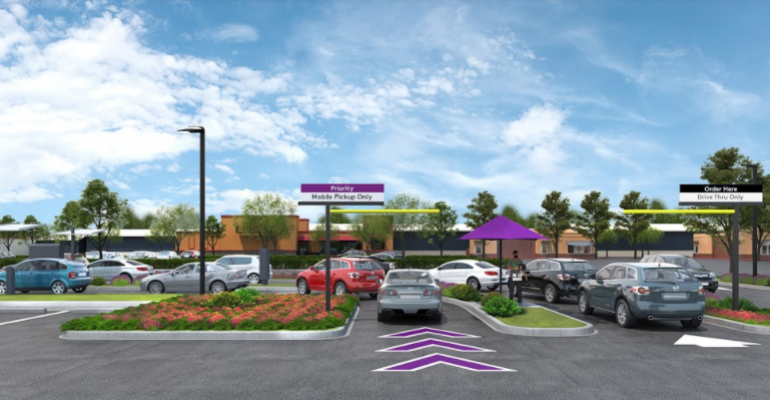A surge in digital sales lifted Yum Brands in its latest quarter, but the company still faces the same problem: challenges at Pizza Hut.
During the quarter, Pizza Hut closed 672 locations, nearly half of which came from the NPC International Chapter 11 filing, the company said.
“We consented to up to 300 mutually selected closures of underperforming and primarily dine-in stores,” Chief Financial Officer Chris Turner told investors during Yum’s third-quarter conference call Thursday. “These closures are largely complete.”
Still, despite the closures, Pizza Hut’s U.S. division recorded same-store sales growth of 6%, driven by strong off-premise sales.
Digital sales at all brands lifted Yum Brands for the quarter. The company reported a 2% decline in global same-stores sales for its three core brands with Taco Bell posting a 3% gain.
Taco Bell’s turnaround is significant given that the brand, its best performer prior to the pandemic, had struggled at the start of the crisis.
Now, the chain is back firing on all cylinders, having returned breakfast to the menu at most stores, trimmed the menu and added more value offerings. That’s led to drive-thru demand. Taco Bell drive-thrus served 230 million cars in the quarter, more than 30 million more cars year-over-year.
Taco Bell, which has eliminated several menu items over the past year, has improved wait times at the drive thru. The brand is about 17 seconds faster compared to last year.
“Taco Bell also continued to focus on a faster and easier customer experience by expanding aggregator partners and digital reach while breaking records in drive-thru times,” CEO David Gibbs told investors.
The brand reintroduced innovation and value to the menu with products like the Grilled Cheese Burrito, the $5 Grande Nachos Box and $1 Nacho Crunch Double Stacked Taco. The company also added new third-party delivery operators during the pandemic.
Taco Bell CEO “Mark King and his team have done an amazing job of pivoting in this environment to meet the consumers’ new needs,” Gibbs said.

Taco Bell is bringing back the Toasted Cheddar Chalupa in November.
Next month, Taco Bell plans to bring back the Toasted Cheddar Chalupa, where aged cheddar is toasted onto a chalupa shell.
Yum Brands is joining a growing number of limited-service restaurant companies that are seeing vast improvements in same-store sales after experiencing severe declines in the first few months of the pandemic.
“COVID continued to impact the business, both in terms of temporary closures of restaurants and limitations on the use of dining rooms, which some of our markets heavily rely upon,” Gibbs said.
But the crisis has also highlighted how important off-premise channels are for the company, including digital orders. During the quarter, Yum’s digital business reached $4 billion, a $1 billion step up from the same quarter in 2019.
As such, “we intend to use this momentum to further advance the off-premise category and continue to decrease our dine-in asset footprint,” said Gibbs, who stepped in as CEO in early January.
Gibbs pointed to Taco Bell as an innovator in the digital space.
During the pandemic, Taco Bell announced plans to build smaller footprint stores that cater to on-the-go consumers. Dubbed Taco Bell Go Mobile, these stores will have double drive-thrus and curbside pickup.
The twin lanes will have different purposes. One will be a traditional quick-service drive-thru lane, where customers order, pay and get their food. The second lane is a “priority” lane geared for picking up mobile orders, a trend that is picking up across the indutry during the pandemic.
The Go Mobile format will have less dine-in space with a footprint of 1,400 square feet. Most Taco Bell restaurants are about 2,000 square feet.
Gibbs did not give a time frame for the rollout, only saying the new concept is a “winning formula” for consumers and franchisees, as the economics are better.
“Stay tuned for more about this exciting development opportunity,” Gibbs said.
Yum plans to leverage drive-thrus at its newest brand, The Habit Burger Grill. The Irvine, Calif.-based fast-casual burger chain saw same-store sales decline 3%.
“The Habit restaurants with drive-thru capabilities are performing exceptionally well and are yet another proof point for us as we continue to position the brand to fit the needs of consumers today,” Gibbs said.
U.S. restaurant counts at the end of quarter: KFC (3,995); Pizza Hut (6,676); Taco Bell (6,798) and Habit Burger (274)
Contact Nancy Luna at [email protected]
Follow her on Twitter: @fastfoodmaven
Update, Oct. 29, 2020: This story was edited to clarify the number of cars in Taco Bell's drive thru.





